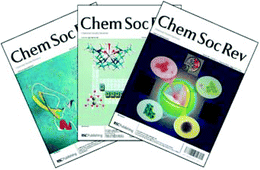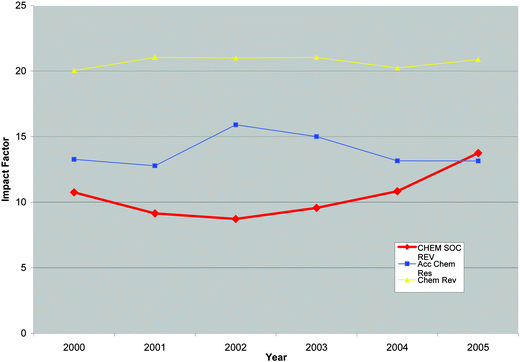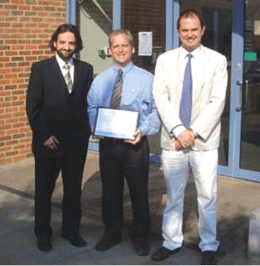Editorial—building on success
2006
Throughout 2006 Chem Soc Rev has continued to develop and maintain its position as one of the leading review journals in the chemical sciences. The number of reviews published in the journal grew by 18%—the third year in succession that such a large increase has been achieved—whilst maintaining the high standard of review material appearing in its pages. In 2006, Chem Soc Rev published its first RSC Awards review, covering the exciting topic ‘Inferring the chemical mechanism from structures of enzymes’. Written by Professor Jim Naismith, University of St Andrews, the review is related to the work for which he was awarded the RSC Corday–Morgan Medal in 2005 (Chem. Soc. Rev., 2006, 35, 763–770). The publication of social interest reviews continued in 2006, with three reviews appearing during the year on topics of general interest: ‘Biochemistry of the skin’, ‘Automotive fuels’ and ‘Conservation in shipwrecks’. Table 1 shows the top ten most accessed reviews published in Chem Soc Rev in 2006.| Review title | Citation |
|---|---|
| a Data set taken from 1st January 2006 to 13th November 2006 | |
| Organic chemistry in water | Chem. Soc. Rev., 2006, 35, 68–82 |
| Advances in chemistry applied to forensic science† | Chem. Soc. Rev., 2005, 34, 1021–1030 |
| Self-organization of disc-like molecules: chemical aspects | Chem. Soc. Rev., 2006, 35, 83–109 |
| Biochemistry of human skin—our brain on the outside† | Chem. Soc. Rev., 2006, 35, 52–67 |
| Differential receptor arrays and assays for solution-based molecular recognition | Chem. Soc. Rev., 2006, 35, 14–28 |
| Size matters: why nanomaterials are different | Chem. Soc. Rev., 2006, 35, 583–592 |
| Why gold nanoparticles are more precious than pretty gold: Noble metal surface plasmon resonance and its enhancement of the radiative and nonradiative properties of nanocrystals of different shapes | Chem. Soc. Rev., 2006, 35, 209–217 |
| Asymmetric transfer hydrogenation: chiral ligands and applications | Chem. Soc. Rev., 2006, 35, 226–236 |
| Chemical genetics to chemical genomics: small molecules offer big insights | Chem. Soc. Rev., 2005, 34, 472–482 |
| Multifunctional molecular carbon materials—from fullerenes to carbon nanotubes | Chem. Soc. Rev., 2006, 35, 471–487 |
It is particularly pleasing to see the inclusion of two social interest reviews (marked † in the table) on wider topics of general interest in the most accessed review list of 2006. Also notable is the popularity of reviews on topics such as nanomaterials, catalysis, chemical biology and green chemistry.
Themed issues
One of the most exciting developments of 2006 was the publication of three world class themed issues (see Fig. 1). In June, editorial board member Professor Chris Orvig, University of British Columbia, guest edited an issue on lanthanides in medicine and inorganic medicinal chemistry. This was followed in October by a themed issue on the topic of chemistry at high pressure, guest edited by Professor Paul McMillan, University College London. This issue covered a diverse range of research areas from biochemistry to materials science. Publication of the issue also coincided with the centenary of Percy Bridgeman's first works in high pressure for which he later received the Nobel Prize for physics in 1946. The success of the issue was also confirmed when the review by Professor Isabel Daniel entitled ‘Origins of life and biochemistry under high-pressure conditions’ (Chem. Soc. Rev., 2006, 35, 858–875) was highlighted in the wider scientific press. | ||
| Fig. 1 Chem Soc Rev covers from the 2006 themed issues. | ||
Finally in 2006, the journal published a themed issue covering the topic of nanostructured assemblies. This issue, guest edited by editorial board members, Professors Jon Preece and Fabio Biscarini and Dr Wilhelm Huck, also covered a wide range of topics from polymer and organic nanomaterials to inorganic nanostructures through to surfaces and supramolecular chemistry. This was the largest issue of Chem Soc Rev published to date featuring 13 world class reviews from leading international authors. But it is not just Chem Soc Rev that is publishing high-quality papers on nanoscience—due to the interdisciplinary nature of the subject area other RSC Journals and Books also include related content. This wealth of nano material has now been brought together in one convenient webpage, which is regularly updated with the latest research and books from RSC Publishing. Visit: www.rsc.org/publishing/journals/nanoscience/
Impact factor
It is with great delight we can report that the journal impact factor increased for the fourth year in succession to reach 13.75, an all time high for the journal. Chem Soc Rev leapt from the third highest ranking journal in the multidisciplinary chemistry category to the second, overtaking its ACS counterpart, Accounts of Chemical Research, for the first time (see Fig. 2). | ||
| Fig. 2 Graph showing the change in impact factor over the last 6 years (Thomson ISI®). | ||
This rise in impact factor was mirrored across the RSC journal portfolio when the 2005 impact factors were released by ISI® in June 2006 with RSC journals showing an impressive average increase of over 10%. Calculated annually, ISI® impact factors provide an indication of the quality of a journal—they take into account the number of citations in a given year for all the citable documents published within a journal in the preceding two years.
Work published in RSC Journals is also amongst the most topical. The immediacy index measures how topical and urgent the papers published in a journal are, by dividing the number of citations in a given year by the number of articles published in the journal that year. These impressive new figures reinforce the RSC's reputation as the home of exciting new research.
Chem Soc Rev lecture
A further major development in 2006 was the awarding of the first Chem Soc Rev sponsored lecture. This was delivered by Professor Jeffery Davis at the Southampton Supramolecular Chemistry (SS3) meeting in July (see Fig. 3). Professor Davis was selected to be the first recipient of the award for his continued research excellence and contributions in the field of supramolecular chemistry. To read more about Professor Jeffrey Davis's research interests read his recent Chem Soc Rev review co-authored with Professor Gianpiero Spada (http://xlink.rsc.org/?doi=b600282j). | ||
| Fig. 3 Professor Jeffery Davis receiving the Chem Soc Rev lecture award. Pictured with Chem Soc Rev editor Dr Robert Eagling and editorial board member and organiser Dr Philip Gale. | ||
This prize is just one of many awarded by RSC Publishing during 2006, a year that has seen more than 20 high-profile researchers gain financial support to present their work at events throughout the world, in recognition of their research achievements. More than £15![[thin space (1/6-em)]](https://www.rsc.org/images/entities/char_2009.gif) 000 (or $30
000 (or $30![[thin space (1/6-em)]](https://www.rsc.org/images/entities/char_2009.gif) 000) was granted to the recipients, in total, to cover travel expenses to sponsored lectureships in countries such as China, Japan, US and UK.
000) was granted to the recipients, in total, to cover travel expenses to sponsored lectureships in countries such as China, Japan, US and UK.
Editorial board
At this time it is important to thank editorial board members who will be retiring at the end of 2006. We would like to therefore send special thanks to Professors Eisenstein, Harris, Orvig and De Cola for their help over the past years. We are also delighted to welcome new editorial members, Dr David Spring (Cambridge University) and Professors Adriano Zecchina (Università di Torino) and Joseph Caruso (University of Cincinnati) who have all recently joined the editorial board and will help to shape the journal in the future.We would like to extend special thanks at this time to Professor David Parker who will complete his four year term as Chair, at the end of 2006. Professor Parker joined the journal as Chair in 2002, and has helped to steer it through a period of rapid growth. Since 2002 the frequency of Chem Soc Rev has doubled from 6 to 12 issues whilst the number of reviews has increased by over 30%. A further key development in this period has been the successful inclusion of critical reviews, which now make up a quarter of the journal's overall content. Most exciting of all, however, is the continued growth in impact factor to a record high of 13.75 (ISI® 2005), with an overall increase of 37% since 2002. We would like to personally thank Professor Parker for his efforts in helping to guide both the journal and the excellent editorial board members through this exciting and successful period.
2007
New chair
Looking forward to 2007, this promises already to be an excellent year continuing the rapid growth and development seen in previous years. It is with great pleasure that we announce that Dr Wilhelm Huck, Cambridge University, has agreed to lead the editorial board as Chair for the next four years. Dr Huck has been a member of the editorial board for four years and hence continues his involvement with the journal through the exciting times which lie ahead.Commissioning
Editorial content for the journal continues to be of an excellent quality moving into 2007 with an array of world leaders and excellent young scientists contributing to the first issue of 2007. Plans are now in place which will see the number of reviews published increase again, with a target of over 100 reviews for the first time in the journal’s history.Both the editorial board and I will look to continue to build on the journal strengths, commissioning across the whole of the chemical sciences whilst maintaining a particular focus on cutting edge analytical and physical chemistry as well as the interdisciplinary area of chemical biology.
Forthcoming themes
Building on the success of 2006, Chem Soc Rev will continue to publish a series of high profile themed issues on a range of exciting topics. For 2007 these include ‘Organometallics in heterocyclic synthesis’, guest edited by editorial board members Professors Bolm and Davies, ‘Liquid crystals’ guest edited by Professor Jon Preece and Professor John Goodby from the University of York and ‘Gas phase kinetics’ commissioned by editorial board member Professor George Marston. Most exciting however is the supramolecular chemistry anniversary issue scheduled for publication in early 2007. The issue has been commissioned by editorial board member Dr Philip Gale, University of Southampton, and will contain a collection of around 20 reviews from leading international supramolecular chemists. The issue has been brought together to celebrate the early works of Charles Pedersen in the field of supramolecular chemistry and also the award of the Nobel Prize in 1987 to Jean-Marie Lehn, Charles Pedersen and Donald Cram. In addition to reviews, the issue will also contain personal accounts of Charles Pedersen and of Donald Cram from Professor Reed Izatt and Professor John Sherman. The issue will begin with a highlight from Professor Jean-Marie Lehn looking towards how the subject may evolve in the future with the potential move from supramolecular chemistry to constitutional dynamic chemistry and adaptive chemistry. This promises to be an exciting issue and one not to be missed.Finally, 2007 will see the awarding of the Chem Soc Rev sponsored lecture at a high profile international meeting. This will be complemented by the introduction of the Chem Soc Rev Young Investigator sponsored lecture which will be awarded to an up and coming young chemist, also at an international meeting in 2007. For further information and announcements please watch the Chem Soc Rev website.
Developments across RSC publishing
RSC open science
Authors publishing in RSC Journals now have the option of paying a fee in exchange for making their accepted communication, research paper or review article openly available to all via the web, with RSC Open Science. The scheme is only made available to authors once their papers have been accepted for publication, following the normal rigorous peer-review procedures (RSC Open Science operates in parallel with the normal publication route, which remains free to authors). Authors who have published their work in RSC journals are also able to retrospectively apply for their work to be included in the scheme. Further information can be found at: www.rsc.org/openscienceWhat our authors say
We are always happy to receive feedback from authors, especially if it helps us to further improve the publishing experience. Because we believe that RSC Publishing offers the best service of any scientific publisher, we have published a selection of the comments we have received from authors from around the globe – take a look at www.rsc.org/authorquotesTechnological advances
2006 has seen RSC Publishing invest significantly in technological developments across all of its products. Introduced last year, RSS feeds, or ‘really simple syndication’, have proved extremely popular with our readers. Subscribers receive alerts as soon as an Advance Article is published in their journal of choice, providing both the graphical abstract and text from a journal's contents page. You can subscribe via the Chem Soc Rev homepage.Subscribers to Chem Soc Rev will now link from journals' contents lists straight through to the HTML view of selected articles, in just one quick step. Here you can download references to citation managers (such as EndNote, Ref Manager, ProCite and BibTex), sign up for RSS feeds, search for citing articles (otherwise known as ‘forward linking’), print the article with just one click and send the article to a friend or colleague.
From 2007, authors publishing in RSC journals will see their science “come alive” thanks to an exciting new project pioneered by the RSC. Enhanced HTML in RSC articles will allow chemical and biological compounds mentioned in the text to be identified; by clicking on the compound readers will be able to obtain further information about that compound, including a downloadable structure plus a list of relevant subject areas. The RSC is the first publisher to utilise the International Chemical Identifier (InChI) (a digital equivalent of the IUPAC name for any particular covalent compound where structures are expressed in terms of five layers of information—connectivity, tautomeric, isotopic, stereochemical, and electronic) for a project of this type and scope. The technology will be used to enhance RSS alerts so that future news feeds can include chemical structures and other enhanced information. RSC Publishing intends to evolve this project to match author and reader needs, so tell us what you think: we welcome your feedback on this new functionality and will incorporate your ideas to develop the service further. Find out more at www.rsc.org/sciencecomealive
These developments demonstrate the investment in publishing products and services over the past year and 2007 will see us enhancing our products further.
Changes and developments to chemical Science, chemical technology and chemical biology and news of chemistry world
Showcasing hot science from RSC Journals in Chemical Science, Chemical Technology and Chemical Biology has proved very popular with readers and authors alike. In fact, the free supplements have become so successful that from January 2007, all issues will be eight pages (in print), contain new article types and come complete with a fresh new look for the front page. Supplementary material will also be available online.Meanwhile Chemistry World, the RSC's award-winning magazine, launched two new web features at the end of 2006. The Chemistry World Blog is an interactive forum for news, discussion and opinion, looking at the science hitting the headlines. The Chemistry World Podcast interviews high profile scientists about the latest and hottest topics in science, and is free to download at www.rsc.org/chemistryworld
Not just journals…
As well as an impressive portfolio of prestigious journals, the RSC has a wide selection of products for anyone with an interest in the chemical sciences. Visit the shop at www.rsc.org/shop to browse over 400 book titles, subscribe to or purchase an individual article from Chem Soc Rev or any other RSC journal, join or renew RSC membership, or register to attend a conference or training event.In addition, RSC Publishing is pleased to announce the launch of the RSC eBook Collection. RSC books are now available online and can be easily downloaded as either chapters or books. The collection is fully searchable and also integrated with RSC Journal content. To search the collection or for further information, visit www.rsc.org/ebooks
As you can see 2006 has been both an excellent year for Chem Soc Rev and for RSC publishing in general. Looking forward, 2007 already has the potential to be an even better year for Chem Soc Rev and the editorial board and I hope that with the continued support or both our authors and readers the journal will maintain its position as one of the best review journals in the chemical sciences.
Robert Eagling
Editor – Chem Soc Rev
Wilhelm Huck
Chair – Chem Soc Rev
| This journal is © The Royal Society of Chemistry 2007 |
